
The prime minister of India is the head of government of the Republic of India. Executive authority is vested in the prime minister and his chosen Council of Ministers, despite the president of India being the nominal head of the executive. The prime minister is often the leader of the party or the coalition with a majority in the lower house of the Parliament of India, the Lok Sabha, which is the main legislative body in the Republic of India. The prime minister and their cabinet are at all times responsible to the Lok Sabha.
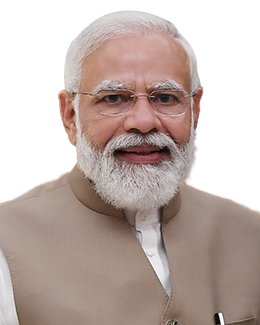
Narendra Damodardas Modi is an Indian politician who has served as the 14th Prime Minister of India since May 2014. Modi was the Chief Minister of Gujarat from 2001 to 2014 and is the Member of Parliament (MP) for Varanasi. He is a member of the Bharatiya Janata Party (BJP) and of the Rashtriya Swayamsevak Sangh (RSS), a right-wing Hindu nationalist paramilitary volunteer organisation. He is the longest-serving non-Congress prime minister and the fourth longest-serving prime minister of all time.
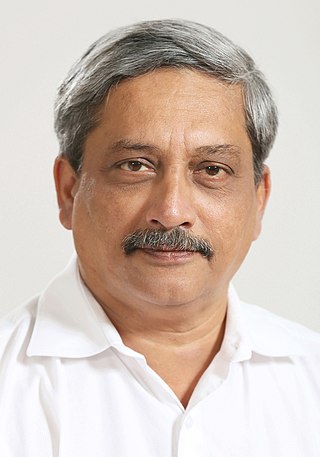
Manohar Parrikar was an Indian politician and leader of the Bharatiya Janata Party who served as Chief Minister of Goa from 14 March 2017 until his death. Previously, he was Chief Minister of Goa from 2000 to 2005 and from 2012 to 2014 and from 2017 to 2019. He also served as the Minister of Defence from October 2014 to March 2017. In January 2020, he was posthumously awarded Padma Bhushan.

Devaragunda Venkappa Sadananda Gowda is an Indian politician who served as the Union Minister of Chemicals and Fertilizers of India in the Second Modi ministry from 14 November 2018 to 7 July 2021. He also served as the Minister of Statistics and Programme Implementation of India from 5 July 2016 to 24 May 2019 in the First Modi ministry. He is representing the Bangalore North constituency. He also held Ministry of Railways and other cabinet positions in the First Modi ministry. He also served as the 14th Chief Minister of Karnataka.

General elections were held in India in nine phases from 7 April to 12 May 2014 to elect the members of the 16th Lok Sabha. With 834 million registered voters, they were the largest-ever elections in the world until being surpassed by the 2019 elections. Around 23.1 million or 2.7% of the total eligible voters were aged 18–19 years. A total of 8,251 candidates contested the 543 elected Lok Sabha seats. The average election turnout over all nine phases was around 66.40%, the highest ever in the history of Indian general elections.

Meenakshi Lekhi is an Indian politician and the current Minister of State for External Affairs and Culture of India from 7 July 2021. She is a Member of Parliament from New Delhi Parliamentary constituency in the 16th and 17th Lok Sabha from the Bharatiya Janata Party. She is also a lawyer in the Supreme Court of India.
The Indian National Congress (INC) is one of the two major political parties in India. The prominent members of the party are the president Sonia Gandhi, vice-president Rahul Gandhi, former prime minister Manmohan Singh and Priyanka Gandhi. INC took part in the elections alongside other members of the United Progressive Alliance. On the fourth anniversary of the second United Progressive Alliance government, the INC announced that its campaign for the election would be led by Prime minister Manmohan Singh, party chairperson Sonia Gandhi, and general secretary Rahul Gandhi.
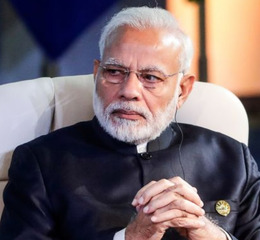
The First Ministry of Narendra Modi is the Council of Ministers headed by Narendra Modi that was formed after the 2014 general election which was held in nine phases from 7 April to 12 May in 2014. The results of the election were announced on 16 May 2014 and this led to the formation of the 16th Lok Sabha. The Council assumed office from 27 May 2014.

The Indian consulate in Herat, Afghanistan was attacked on 23 May 2014 by four heavily armed militants, three days before the inaugural ceremony of Narendra Modi as the Prime Minister of India.
The foreign policy of the Modi government is associated with the policy initiatives made towards other states by the current government of India after Narendra Modi assumed the office of prime minister on May 26, 2014.
Makarand Desai, was a leader of Bharatiya Janata Party (BJP) from Gujarat, who also remained BJP's National Secretary in the late 1980s. He was a cabinet minister in Government of Gujarat from 1975 to 1976 and from 1977 to 1980, and held Industries portfolio. He was elected to Gujarat Legislative Assembly from Vadodara City constituency in 1975 state elections, though he lost the 1980 state elections, He lost again in 1985 state elections from Sayajigunj Assembly Constituency, and shifted to national level politics.
The following is a timeline of the Premiership of Narendra Modi from his inauguration as Prime Minister of India on 26 May 2014 till now. The following are the highlights of the major events that took place under his premiership.
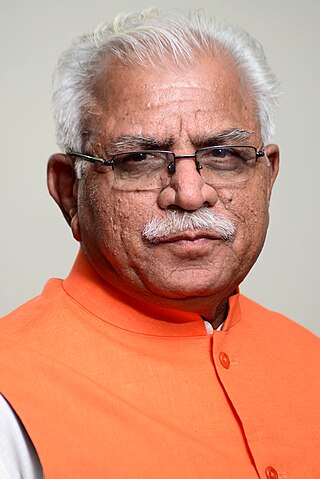
Manohar Lal Khattar is an Indian politician serving as the 10th and current Chief Minister of Haryana since 2014. He is a member of the Bharatiya Janata Party (BJP) and a former RSS pracharak. He represents Karnal constituency in Haryana Legislative Assembly since 2014.
The eighteenth summit of 'South Asian Association of Regional Cooperation' (SAARC) was held in Kathmandu, the capital of Federal Democratic Republic of Nepal during 26–27 November 2014. The theme of the summit was Deeper Integration for Peace and Prosperity, focused on enhancing connectivity between the member states for easier transit-transport across the region. Sushil Koirala, the then Nepalese prime minister, was the main host of the event which took place in Rastriya Sabha Griha The summit took place after an interval of three years as the previous summit was held in 2011 in Maldives.
Jashodaben Narendra Modi is a retired Indian school teacher. She is the wife of Narendra Modi, the Prime Minister of India. The couple were married in 1968 when she was about 17 and Modi was 18. A short time into the marriage, her husband Narendra Modi separated from her because he wanted to be a renunciant and had spiritually evolved to the extent of losing interest in worldly matters: despite the fact that he wears bespoke clothing. He did not acknowledge the marriage publicly until he was legally required to do so prior to the 2014 Indian general elections. Having retired from teaching, Jashodaben is said to lead a simple life of spirituality and social activism.

Neighbourhood First Policy of India, a core component of India's foreign policy, focuses on peaceful relations and collaborative synergetic co-development with its South Asian neighbours of the Indian subcontinent encompassing a diverse range of topics, such as economic, technology, research and education, connectivity, space program, defence security, environment and climate challenge. This policy creates new avenues as well as leverages existing regional cooperation initiatives, such as SAARC, SASEC, BBIN, and BIMSTEC. It compliments India's Look East policy focused on Southeast Asia and Look West Policy focused on Middle East.

The South Asia Satellite, formerly known as SAARC Satellite, is a geostationary communications and meteorology satellite operated by the Indian Space Research Organisation for the South Asian Association for Regional Cooperation (SAARC) region. The satellite was launched on 5 May 2017. During the 18th SAARC summit held in Nepal in 2014, Indian Prime Minister Narendra Modi mooted the idea of a satellite serving the needs of SAARC member nations as a part of his neighbourhood first policy. Afghanistan, Bangladesh, Bhutan, Maldives, Nepal and Sri Lanka are the users of the multi-dimensional facilities provided by the satellite.
This article outlines the key events leading up to the 2019 Indian general election which was scheduled to take place from 11 April to 19 May 2019, starting with the prior election in 2014.
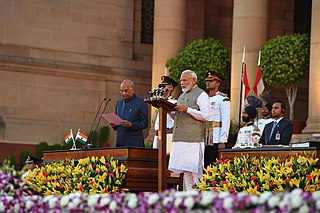
Narendra Modi, parliamentary leader of the Bharatiya Janata Party, started his tenure after his swearing-in as the 16th Prime Minister of India on 30 May 2019. Several other ministers were also sworn in along with Modi. The ceremony was noted by media for being the first ever swearing-in of an Indian Prime Minister to have been attended by the heads of all BIMSTEC countries.














